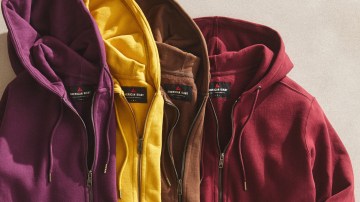This week, a look at how Stitch Fix is revamping its business with new product offerings as it aims to navigate a difficult economic climate.
When Stitch Fix reported its second-quarter earnings in March, CEO Matt Baer emphasized that one of the company’s biggest priorities was expanding Fix flexibility.
Fixes are Stitch Fix’s term for the box of personally-styled clothes its customers get with each order. They pay $20 to receive a box of five to eight items, and they pay for only what they keep — the $20 goes toward any purchases made. Expanding the options available to its customers with each Fix was paramount to the company’s efforts to turn around declining revenue and a shrinking audience.
Now, Stitch Fix is rolling back the curtain on how it’s making its Fixes more flexible. On Thursday, Stitch Fix unveiled four new strategies to enhance its offerings to customers. First, shoppers can select a single item and have a Fix built around it. For example, a statement jacket could be shipped with several different bottoms to go with it. Second, customers can now order themed fixes, built around central premises like summer vacation or golf casual. Third, all customers can now get a Fix with eight items, which was previously limited to only existing customers when it was first introduced last year — new customers were restricted to five items.
The final piece is a significantly increased investment in inventory. Stitch Fix is adding thousands of new pieces to its inventory this year across all categories.
Stitch Fix is the latest of many fashion businesses looking to revamp their strategies. Tariffs and economic uncertainty are rapidly altering consumer behavior, leading fashion brands to consider raising prices, laying off workers and shifting their focus to different markets.
Tony Bacos, Stitch Fix’s chief product and technology officer, said the Stitch Fix team wants to balance having a wide variety of options with a curated shopping experience. Bacos cited internal data Stitch Fix polled from its user base finding that 90% of its clients say they struggle to determine which styles work best for them while shopping online. Sixty-six percent said they find endless choices overwhelming.
“We deliver a better way to shop, and we do this through our team of expert stylists and proprietary algorithms built from the billions of insights we’ve gathered on style and fit,” Bacos said. “Our announcement this week is about how we are bringing our clients even more ways for them to discover the clothing and accessories they will love.”
The focus on inventory is a common theme among rental and styling services. Rental and fashion membership services like Vivrelle and Rent the Runway have made it clear that investing heavily in inventory and offering customers the widest variety of choice is the best way to communicate value. But it doesn’t come cheap. Stitch Fix’s inventory levels have been rising. It currently holds around $109 million worth of inventory compared to $97 million in August of 2024.
It seems to be working for Stitch Fix so far. The company has seen adoption of the larger Fix option increasing every quarter since its inception. Customers who make use of the larger size Fix also tend to have higher average order values, spending more on each purchase.
Stitch Fix has struggled with shrinking clientele in recent years, with its audience dropping by 15% year-over-year in the last quarter, leaving its current active client base at 2.37 million people. In addition, its revenue fell 5% year-over-year.
But recent efforts are beginning to turn things around. In August of last year, Baer laid out a plan in a blog post entitled “Beginning to Reimagine Stitch Fix” that focused the company’s turnaround on more inventory, more flexibility and a greater emphasis on the personalization of its styling service. In March, the company reported better-than-expected results that piqued investor confidence and sent its stock price surging.
“We believe that offering this increased level of flexibility helps our clients navigate seasonal transitions, outfitting solutions and changes in their fit profile, and that this change will become an important driver of long-term engagement,” Baer said in March.
Tariffs are not a special concern for Stitch Fix at the moment. Its private label brands are manufactured in a variety of countries, so it isn’t overly exposed in any one market. Plus, a tariff task force within the company is prepared to shift its inventory mix away from any brands or private labels that are impacted by tariffs to others that are less affected. Unlike many companies, Stitch Fix currently doesn’t plan to raise prices and doesn’t expect that tariffs will significantly impact margins in the second half of the year.
Stat of the week
Customers want perks for their loyalty more than ever, according to data from the business tech company Adyen. But there’s a disconnect between what customers expect and what they’re getting.
According to a survey Adyen conducted over the last three months, 30% of customers say in-store shopping must come with perks like cafés or regular events. And 43% say loyalty programs don’t deliver rewards that they find relevant. In addition, 44% of customers say charging loyal customers for returns is unfair.
All together, the data points suggest consumers aren’t happy with the benefits they’re receiving or with the new concessions like paid returns they’re being asked to make.
News to know
- On Wednesday, Capri Holdings’ CFO Tom Edwards said on its fourth-quarter earnings call that it will likely raise prices among some of its brands, including Michael Kors. The price increases would come, expectedly, as a result of tariffs. Capri sold off one of its largest brands, Versace, to Prada in April for over $1 billion. Michael Kors has seen 10 straight quarters of declining revenue.
- In its first-quarter earnings results on Wednesday, Macy’s also warned investors this week of potential price increases and slashed its profit forecast for the rest of the year, in light of tariffs. Macy’s joins many other retailers, including Walmart, which have publicly stated that the tariffs are unsustainable without raising prices.
- While larger companies like Walmart and Macy’s can raise prices, analysts have warned for months that smaller companies may fold entirely under pressure created by new tariffs. Pari Passu, a New York City-based plus-size womenswear brand founded in 2017, announced it is closing up shop on June 2 due to economic pressure from tariffs making continued business untenable.
Inside Glossy’s coverage
Inside Chanel’s plan to scale back price hikes and double down on brand equity
Vivrelle co-founders on their new Hamptons pop-up and why inventory is king in rental and resale
Footwear’s future: How tariff fears are fast-tracking smarter, faster production models




